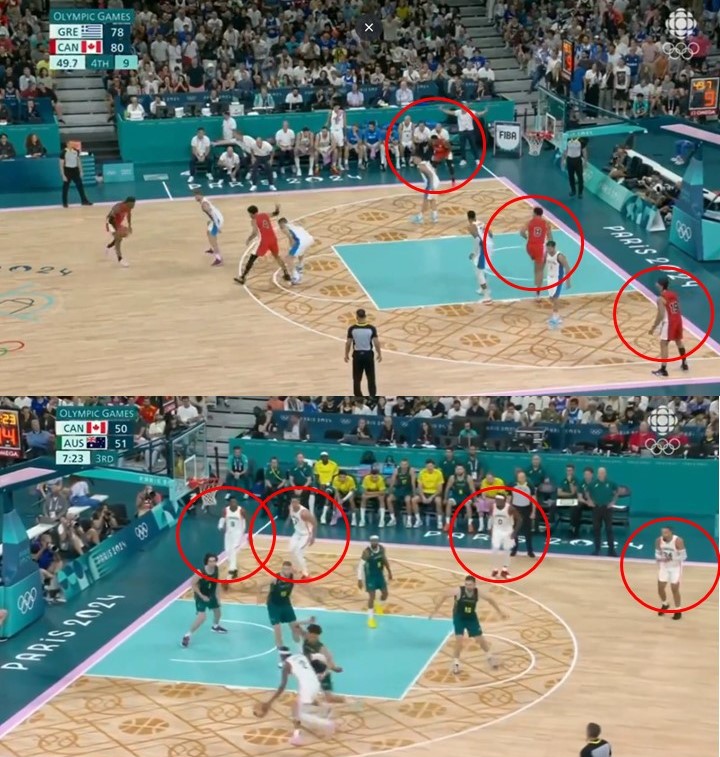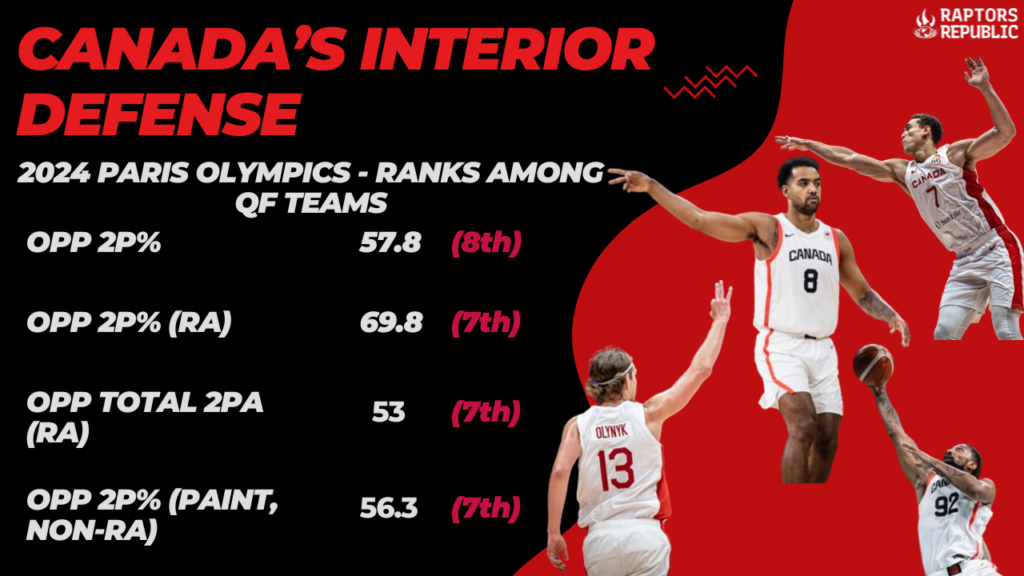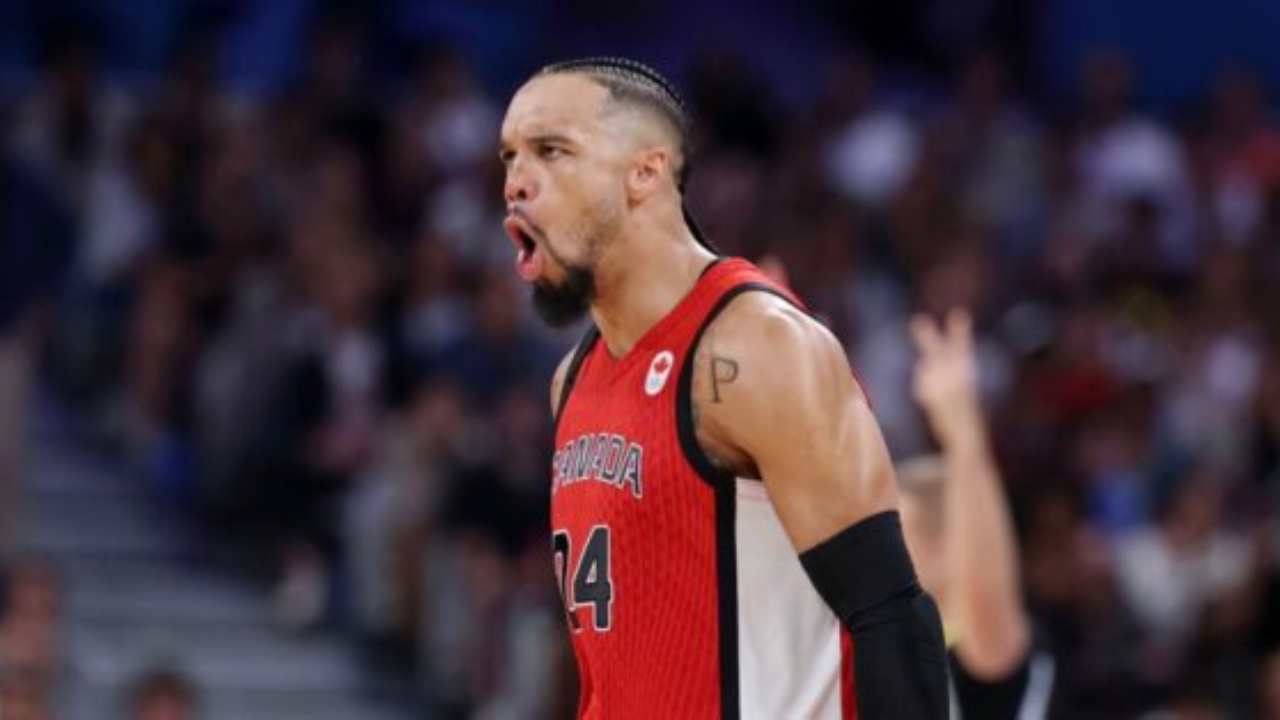After going 3-0 in the most competitive group at the Olympic games, Canada Basketball got a more favourable draw for the knockout stages, avoiding a USA matchup until a potential Gold Medal game. Still, the path to a medal won’t be easy as Canada faces off against the hosts, France, (although they have looked shaky throughout the tournament) and potentially the reigning FIBA 2023 WC Champions in Germany.
Before we look ahead to the Quarter-Finals, let’s take a deep dive into the SMNT’s performance in Group A. How were they able to stay perfect? What tactical adjustments did Jordi Fernández make to empower his players?
Canada’s Death Lineup
One of the biggest challenges for a basketball head coach is finding a 5-man lineup that consistently wins their minutes by a large margin. Coaches and their staff spend ample amount of time tinkering with rotations on paper and experimenting with new lineups on the floor all in search of finding a “Death Lineup”. For many teams, this is a futile effort as their rosters lack the talent, fit, continuity and versatility to establish such a dominant lineup. Thankfully for Canada Basketball on the international stage, that’s not the case.
At the 2023 FIBA WC, the lineup of Gilgeous-Alexander/Dort/Barrett/Brooks/Powell was historically dominant. As I wrote in my preview of the 2024 Paris Olympics, it was this specific lineup that Fernández leaned on in the most pivotal moments last summer. Whether it was against Spain in a do-or-die game in the second round or against the USA in the Bronze Medal game they delivered time and time again.
In fact, the 5-man lineup of Gilgeous-Alexander/Dort/Brooks/Barrett/Powell, which led the Canadian comeback against Spain was the most effective 5-man lineup at the 2023 World Cup. They recorded a ridiculous +49.6 per 40 min net rating, powered by an elite offense (143.8 OFFRTG) and defense (86.7 DEFRTG). Small sample size aside, it was clear that playing small was Canada’s most effective lineup construction.
Paris 2024 Olympics Preview: The Jordi Fernández Retrospective
That same 5-man lineup that was so dominant last summer has become Canada’s de-facto startling lineup at the Olympics, sliding star guard Jamal Murray to the bench. While Fernández used the “Death Lineup” as more of a trump card at the World Cup, this summer it’s been Canada’s primary weapon to start games off on the right foot. SGA’s offensive brilliance and Barrett’s strength-based curled drives power the Canadian offense while Dort and Brooks hound opposing ball handlers of all sizes on the perimeter. And not to be forgotten, Dwight Powell’s mobility allows Canada to switch every ball screen and disrupt opponent offensive rhythm.
But enough with the superlatives, what do the numbers say about Canada’s Olympic starting five? Through 3 games (24:58 mins overall), the lineup of Gilgeous-Alexander/Dort/Brooks/Barrett/Powell sits at a colossal +33 (+22 vs Greece, +8 vs Australia, +3 vs Spain). Canada has yet to shoot under 50% from the field with their “Death Lineup” on the floor and have managed to hold opposing teams to just 9/32 shooting (28.1% FG%) while forcing 16 turnovers.
Obviously three games is a small sample size. However, when we consider the strength of Canada’s opponents in Group A (two of which qualified for the Quarter-Finals) and the 2023 FIBA WC run, it’s clear that Canada’s starting lineup is their version of the “Death Lineup”.
Creating Space for Shai Gilgeous-Alexander (2.0)
One of the things I have been paying close attention to in Group Play is how Canada has empowered Shai Gilgeous-Alexander on offense. And by “empower” I mean how Fernández has created pockets of space for SGA to attack despite all the defensive attention he garners.
The first adjustment from the Canadian coaching staff in Paris mirrors the adjustment they made last year at the WC (which I have already written extensively about). By flattening the off-ball players along the baseline, SGA is free to create from up top. This flattened alignment has been the common theme among the plethora of clutch baskets from SGA the past two summers, including the opening game of the 2024 Olympics against Greece.
In the final Group A game against Spain, Canada once again flattened SGA’s teammates along the baseline and had him create from up top. There’s very few players in the world that are able to keep up with, let alone deter, a SGA drive on an island and that’s exactly what Canada exploits in the clip below. SGA burns his initial defender without a screen, collapses the defense and finds RJ Barrett who drains the game-sealing (and group-sealing) 3.
Now why did I include a “2.0” in this section’s header if this was an adjustment the SMNT already used last year? That’s because Jordi Fernández works tirelessly and tried something else out! Against Australia, Canada did initially go to their “flatten along the baseline” adjustment in the first half. However, in the 2nd half, Canada introduced a wrinkle, deciding to flatten the off-ball players along the opposite sideline instead!

This subtle change in positioning has significant ramifications on where SGA creates from. With his teammates flattened along the opposite sideline, Gilgeous-Alexander attacks from the corner/lower wing with a more horizontal direction of movement as opposed to attacking vertically from up top. He’s closer to the basket and the midrange, where he’s an outlier in terms of scoring efficiency (2nd in the NBA in the regular season and playoffs in midrange FG%). All this to say, this re-imagined alignment of players on the floor suits SGA’s strengths extremely well and I hope we see more of it in the knockout stages.
Canada’s Elite, But Vulnerable Defense
As expected, Canada’s perimeter defense at the Olympics has been suffocating thus far. Led by Lu Dort and Dillon Brooks, Canada’s defense plays and rotates to the ball at a frenetic pace, forcing opposing offenses into chaotic possessions and wrecking havoc on their overall offensive flow. Look no further than the 3rd Q against Australia, where Canada turned over the Boomers 9 times and gained control of a tight contest.
Fernández has achieved the frenetic feel of Canada’s defense by repeatedly extending their ball pressure, whether it’s picking up ball handlers full court or pressing non-shooting bigs when they catch the ball at the elbow to playmake. And to his credit, it has yielded impressive results thus far. In the 3 game Group Stage, Canada was 1st overall in Points off of TOV (22.3 PPG) and forced a total of 6 shot clock violations (double of Greece, who forced the 2nd most shot clock violations in Group A). When teams have successfully gotten into the halfcourt, Canada has remained focused, communicated well off-ball and consistently executed the right rotation. No matter if it was building the wall to defend Giannis, dealing with Australia’s “slip” actions and tendency to crash the offensive glass or Spain’s dizzying actions that flow together seamlessly, Canada’s defensive gameplan stood tall and handled each challenge presented to them.
Despite a strong perimeter defense, there’s a concerning vulnerability that could prove disastrous. Due to Canada’s lack of traditional rim protection and size, they have not been good at defending within the arc. Across all 2PA, Canada’s opponents currently shoot 57.8%, ranking 11th (out of 12 teams) and last among all Quarter-Final teams. If we focus solely on paint attempts, things don’t get much better for Canada. Among the 8 remaining teams in the tournament, Canada ranks second last in both opponent restricted-area (RA) FG% and opponent paint (non-RA) FG%. The Canadian defense is currently being kept afloat by “limiting” opponent 3P% to 29.0% (ranks 1st) while sitting middle of the pack in opponent 3PA (ranks 7th). While I do think Canada has done a good job overall to rotate out and contest 3’s (especially vs Greece), it’s hard to say with a 3 game sample size if they are truly influencing opponent misses or if they have just “gotten lucky”. Defenses have much more influence on limiting the number of 3PA, and as we’ve seen they are currently average at doing so. The underlying problem with this defensive model, especially in the confines of a single game, is it leaves Canada extremely susceptible to 3P variation. Running into one team that gets hot from 3, even if you are able to contest those shots well, could potentially unravel Canada’s so-far elite defense.

These concerning defensive numbers, especially in the paint, are why I think Fernández has aggressively ratcheted up the ball pressure. By doing so, it takes longer for opposing offenses to start initiating in the half-court. Combined with a switch-heavy defensive scheme, the idea here is Canada is trying to stop opposing teams from stepping foot in the paint. Fernández understands that with the current roster, they probably won’t be able to stop team’s from scoring at a high clip from close-range, so they better try everything in their power to limit the number of attempts. So far it’s been somewhat ineffective. Among all Quarter-Final teams, Canada again ranks 7th in RA FGA with 53 over 3 games. Perhaps mixing in some zone defense could help alleviate Canada’s interior defensive issues, but we have yet to see a Fernández-led SMNT try that out.
At the end of the day, I think Canada has shown enough in the Group Stages to establish themselves as a legitimate medal threat this year. There’s some concerning weaknesses and clear strengths as is the case with any team. I’m excited to see how the coaching staff and players problem solve on the fly and perform in the knockout stages.



